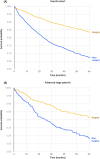Comparative Outcomes of Surgical vs. Non-Surgical Interventions in Advanced Oropharyngeal Cancer: A Large-Scale Retrospective Cohort Study
- PMID: 41078847
- PMCID: PMC12512899
- DOI: 10.1002/lio2.70279
Comparative Outcomes of Surgical vs. Non-Surgical Interventions in Advanced Oropharyngeal Cancer: A Large-Scale Retrospective Cohort Study
Abstract
Objective: To compare short-term complications and long-term survival outcomes between surgical and non-surgical treatments for oropharyngeal cancer.
Methods: We conducted a large-scale retrospective cohort study using the TriNetX Global Collaborative Network, analyzing data from 154,494,403 patients across 128 healthcare organizations. After applying inclusion criteria and propensity score matching, we compared 2413 surgical patients with 2413 non-surgical patients. Primary outcomes included short-term complications at 6 months (dysphagia, gastrostomy tube placement, tracheostomy, respiratory complications) and 5-year all-cause mortality.
Results: At 6 months post-treatment, surgical patients showed higher rates of dysphagia (46.83% vs. 40.61%, RR = 1.15, 95% CI: 1.08-1.23) and respiratory complications (6.30% vs. 3.69%, RR = 1.71, 95% CI: 1.32-2.21). Non-surgical patients experienced increased rates of gastrostomy tube placement (17.86% vs. 6.09%, RR = 0.34, 95% CI: 0.29-0.41) and tracheostomy (7.34% vs. 3.61%, RR = 0.49, 95% CI: 0.38-0.63). Similarly, subgroup analysis of the advanced-stage cohort showed that non-surgical patients had higher rates of gastrostomy tube placement (5.5% vs. 17.5%, RR = 0.31, CI: 0.19-0.52) and tracheostomy (3.1% vs. 6.4%, RR = 0.48, CI: 0.23-0.99). At 5-year follow-up, surgical intervention was associated with significantly lower all-cause mortality (9.9% vs. 25.3%, HR = 0.43, 95% CI: 0.37-0.49). This survival benefit persisted in the advanced-stage subgroup (14.1% vs. 25.5%, HR = 0.53, 95% CI: 0.37-0.76) (p < 0.001).
Conclusions: While surgical treatment for oropharyngeal cancer was associated with higher rates of certain short-term complications, it demonstrated superior long-term survival outcomes compared to non-surgical interventions, including in patients with advanced disease. These findings provide valuable evidence to inform treatment selection and patient counseling in oropharyngeal cancer management.
Level of evidence: 2b.
Keywords: complications; oropharyngeal cancer; propensity score matching; surgical outcomes; survival analysis.
© 2025 The Author(s). Laryngoscope Investigative Otolaryngology published by Wiley Periodicals LLC on behalf of The Triological Society.
Conflict of interest statement
The authors declare no conflicts of interest.
Figures



References
-
- Shibahara T., “Oral Cancer ‐Diagnosis and Therapy,” Clinical Calcium 27, no. 10 (2017): 1427–1433. - PubMed
LinkOut - more resources
Full Text Sources
Research Materials
